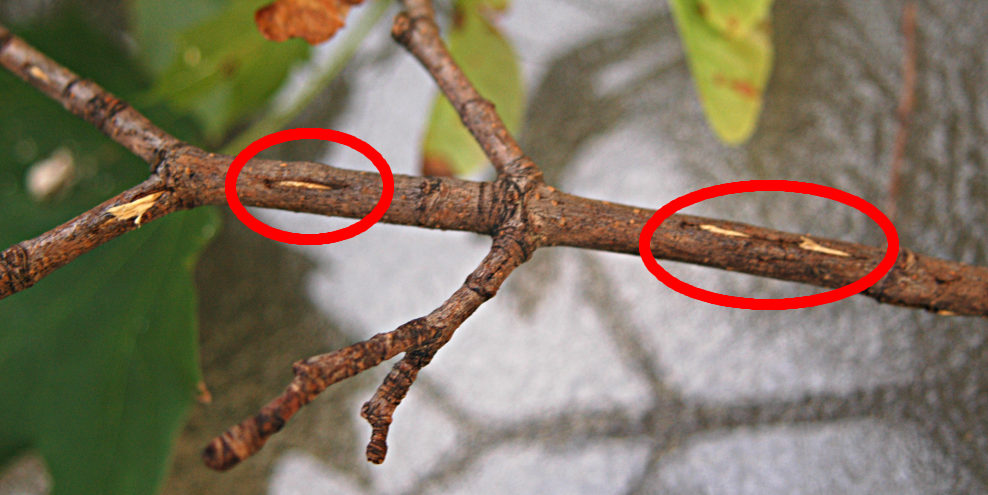By Sandra Nelson
Throughout my childhood, this was the defining (and to be perfectly honest, somewhat creepy) sound of summer to me…
…the raucous calls of hundreds of emerging cicadas.
But the noise wasn’t the whole story — the crunchy abandoned shells scattered all over the place repelled me; I couldn’t wait until they were gone.
Today, these seemingly common, ordinary insects fascinate me; they aren’t at all the villains we have pegged them to be. In fact, cicadas are important contributors to the environment and because of the ability of their wings to repel water and kill bacteria, they may hold a key to opening new doors in biomedical science.
While many in the MIdwest think of cicadas as the dark brown insects with glaring red eyes that emerge en mass every few years, there are actually over 190 varieties in North America and 3,000 different species of cicadas world wide. Their appearances, schedules and locations are as varied as their numbers. Some are the familiar brown, while other varieties are black or green. Some have white or blue eyes and they range in size from three-quarters of an inch to over two inches long. Many species, the periodical ones, emerge after spending years underground, while others, the annual ones — or dog-day cicadas, surface every year in late summer.
All cicadas, whether periodic or annual, have the same three stage life cycle. They begin as eggs, hatch as nymphs and emerge from underground to become ad ults. The time frame underground for development however, changes by species. Adult female cicada lay around 400 eggs. They lay their eggs in a variety of spots, usually slits in trees and branches, where they remain for six to ten weeks. Nymphs hatch from the eggs and immediately burrow underground where they must fend for themselves since the mother cicada abandons the eggs. Unlike other insects that live underground, cicada nymphs do not hibernate; they remain active throughout the winter, tunneling and feeding. Nymphs survive by sucking the liquids of plant roots. While underground, the nymphs molt in five growth cycles called instars.
ults. The time frame underground for development however, changes by species. Adult female cicada lay around 400 eggs. They lay their eggs in a variety of spots, usually slits in trees and branches, where they remain for six to ten weeks. Nymphs hatch from the eggs and immediately burrow underground where they must fend for themselves since the mother cicada abandons the eggs. Unlike other insects that live underground, cicada nymphs do not hibernate; they remain active throughout the winter, tunneling and feeding. Nymphs survive by sucking the liquids of plant roots. While underground, the nymphs molt in five growth cycles called instars.
Although the precise trigger is still unknown, most scientists believe that cicada emergence is tied to two things — changes in the composition of tree root fluids and soil temperatures. When trees begin to leaf out and soil temperatures at a depth of eight inches hit 65 degrees Fahrenheit, then nymphs in the year’s brood or group begin to emerge. They immediately climb a nearby tree, shed their old skin and begin the final, adult stage of their lives. Their wings fill with fluid, allowing them to fly. Their bodies turn from a gelatinous white color to their adult appearance. Within a few days, the males begin to sing, looking to attract nearby females with which to mate. Depending on the species, cicadas live two to six weeks after mating.
Early American settlers branded cicadas as hoards of swarming, destructive locust-like vermin needing to be eradicated. Unfortunately that reputation remained for years. In actuality, cicadas do minimal damage even though they are herbivores. Mature trees and shrubs can usually withstand the feedings from cicadas, even when there are dense clouds of the insects landing at one time. Young trees and shrubs may see flagging, which is breakage of small twigs and branches.
Cicadas play an important role in keeping our environment healthy. They help to naturally prune mature trees as they feed, they aerate the soil as they burrow underground, they add nitrogen to the soil when they die and they are a like an all you can eat buffet for birds, rodents, fish, reptiles and even people.
Next time you hear them singing, instead of complaining about the din, grab the kids and go on a cicada hunt. If you’re lucky, you’ll witness one of the amazing feats of nature.




